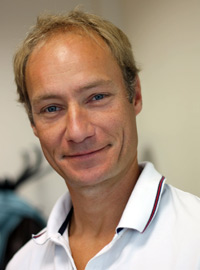
Pierre Sens and cell motility in complex biological systems
The origin of the proposal according to Pierre Sens? “At a meeting in 2010 with a German biologist named Michael Sixt. I heard him mention cell mobility envisaged in a synthetic matrix, i.e. a controllable environment. Unlike many of his colleagues, he considered physical parameters such as friction, elasticity… These are known parameters for physicists, and I understood that there could be a discussion between him and me. It was only later that we simultaneously had the idea of this project. In the meantime, he had talked about it with one of his biologist colleagues, an in vivo specialist, and for my part I had contacted an experimental physicist colleague.” Pierre Sens has set up a multidisciplinary international group consisting of two biologists and two physicists, with very complementary approaches.
The key to success: the desire to talk
"Such a collaboration between specialists in different disciplines is not obvious,” explains Pierre Sens. “The most important thing in my opinion? Having the desire to talk, knowing that each person is perfectly willing to make the effort to understand and be understood. The in vivo biologist works on fish embryos and focuses on the mobility of reproductive cells. Even though we, as physicists, have learnt much in biology since the start of the project, there are a number of parameters which still escape us. The dialogue makes things easier and pushes us forward.”
Pierre Sens, French, working in Paris (theoretical physicist),
Michael Sixt, German, working in Vienna (biologist with in vitro specialisation),
Erez Raz, Israeli, working in Munster (biologist with in vivo specialisation),
Helim Aranda Espinoza, Mexican, conducting research in the USA (experimental physicist).
Unexplained movements
It is necessary to understand that cells move in different ways, depending on their type and the environment in which they develop. Oddly, when a cell is placed flat on a two-dimensional substrate, a front face and a rear face appear. The cell adopts a direction and starts to move. Other cells, observed in a three-dimensional environment, adopt other mobility modes.
– 1996 : Awarded his thesis at the University of Strasbourg,
– 1996-1998 : Postdocs (in the USA and in Israel),
– 1998 : Appointed in charge of research at the CNRS (Strasbourg),
– 2005 : joins the Gulliver Mixed Research Unit in the in the PCT theoretical physical chemistry team at ESPCI ParisTech,
– 2011 : appointed director of research at the CNRS.
How? Why? “We do not know. There must surely be coupling between physical properties and biological decision. We would like to demonstrate this, find the molecular switch and answer the following question: what does a cell do to choose its type of mobility? We are capable of providing physical insight based on a model which the biologists can describe.”
What is the objective of the work financed by the HFSP?
“I want to make a quantitative description based on equations, a sort of “phase diagram”, for cell mobility, which will highlight the importance of physical parameters on the mobility of cells. Last but not least, a further motivation is that this work can help us understand how cancer cells move, and could contribute to the fight against these diseases.”
Next page: A laboratory where interaction between theoreticians and experimentalists promotes discovery.







